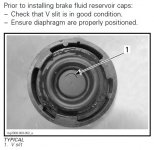Pure conjecture. Get a brake fluid moisture tester to measure it correctly. See reply 9. Take the guess work out of it. :lecturef_smilie:
If the brake fluid never gets any moisture in it, Freddy, and there's no existing contamination &/or rust in the brake lines, then unless you cook the brakes well & truly, the brake fluid won't ever change colour - but you ARE right if you want to take the guess work out of finding out HOW MUCH moisture is in it; the only way to properly do that is with a moisture tester..... or with a whole bunch of fairly expensive laboratory equipment so that you can actually boil the water out, catch it as steam, re-condense it, and measure it! :shocked:
For my 2 bob's worth, even if it's not time to change the brake fluid as per the maintenance schedule, if you've got discoloured brake fluid, then it HAS GOT moisture in it and your braking won't be as good as it could/should be, especially if you ever get the brakes hot, so I'd swap it out even without knowing exactly how much moisture is in there.... :lecturef_smilie: Hang on, that IS exactly what I do! :thumbup:

